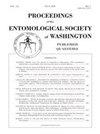New and Easternmost U.S. Records of a Juniper-Specialist Stink Bug, Banasa tumidifrons Thomas and Yonke (Hemiptera: Pentatomidae)
IF 0.4
4区 农林科学
Q4 ENTOMOLOGY
Proceedings of the Entomological Society of Washington
Pub Date : 2022-11-30
DOI:10.4289/0013-8797.124.2.375
引用次数: 0
Abstract
In reviewing the Nearctic species of the pentatomid genus Banasa Stål, Thomas and Yonke (1981) described the new species B. tumidifrons Thomas and Yonke from California, Idaho, and Oregon. Adults, mottled green, yellow and red, are similar to those of the common and widespread B. dimidiata (Say) and the western U.S. B. rolstoni Thomas and Yonke. A tumid (i.e., swollen, enlarged) frons distinguishes B. tumidifrons from similar-appearing species of the genus, especially B. dimidiata. Adults of B. tumidifrons were collected from juniper (Juniperus: Cupressaceae) in Idaho and Oregon (Thomas and Yonke 1981). Zack et al. (2012) added Washington State to the known range. I previously added Colorado, Kansas, Nebraska, South Dakota, and Wyoming to the distribution of B. tumidifrons and established that nymphs develop on fruits (berries) of female plants of its dioecious hosts: eastern redcedar (J. virginiana L.) (hereafter redcedar) and Rocky Mountain juniper (J. scopulorum Sarg.) (Wheeler 2015). I since discovered that Schuh’s (2022) Heteroptera Species Pages list records from Colorado (1985) and Wyoming (1999) that precede my collections from those states, a record from Oregon (1964) older than that cited in the original description (Thomas and Yonke 1981), and a record for Washington (1980) that predates that of Zack et al. (2012). These nine states are listed in the recent summary of the distributions of Pentatomidae north of Mexico (Rider and Swanson 2021). Records of B. tumidifrons (Wheeler 2015) were omitted from the recent additions to the Nebraska list of Pentatomidae (Ademokoya 2021). My easternmost record (101°41.11'W) for B. tumidifrons was Bird City, Kansas. I underestimated its potential eastern spread (Wheeler 2015) and here extend its known eastern range to northeastern Nebraska, and present Montana and North Dakota as new state records. I collected the pentatomid by beating branches of female redcedars, placing adults and nymphs in plastic snap-cap vials, and sorted nymphs to instar in the field. As a check on accuracy, each nymphal instar (indicated by Roman numerals under specimens examined) at a site was collected and verified with a stereoscope, as previously described (Wheeler 2015). The presence of co-occurring adults of B. sordida (Uhler) and B. euchlora Stål was recorded and representatives were collected as vouchers. Fifth instars thought to be B. tumidifrons (n = 5) and B. sordida (n = 2) were reared to adulthood to verify the association. In addition to the six counties previously recorded from the Nebraska panhandle (Wheeler 2015), I collected B. tumidifrons at 25 sites in 17 additional counties of the state, including the extensive Sandhills. Twenty-one nymphs and 113 adults were observed. Fewer numbers of the two PROC. ENTOMOL. SOC. WASH. 124(2), 2022, pp. 375–379美国东部一种刺柏专用臭虫新记录(半翅目:蝽科)
Thomas和Yonke(1981)在综述Banasa Stål属的近北种时,描述了来自加利福尼亚州、爱达荷州和俄勒冈州的新种B.tumidifrons Thomas和Yonke。成虫有斑驳的绿色、黄色和红色,与常见且广泛分布的迪米迪亚塔B.dimidiata(Say)和美国西部的罗斯托尼·托马斯和扬克B.rolstoni Thomas and Yonke相似。tumid(即肿胀、增大)的复叶将B.tumidifron与该属中出现的类似物种区分开来,尤其是B.dimidiata。从爱达荷州和俄勒冈州的杜松(Juniperus:Cupressaceae)中采集了tumidifron的成虫(Thomas和Yonke 1981)。Zack等人(2012)将华盛顿州加入已知范围。我之前将科罗拉多州、堪萨斯州、内布拉斯加州、南达科他州和怀俄明州加入了B.tumidifron的分布范围,并确定若虫是在其雌雄异株寄主的雌性植物的果实(浆果)上发育的:东部红雪松(J.virginiana L.)(以下简称红雪松)和落基山杜松(J.scoperum Sarg.)(Wheeler 2015)。此后,我发现Schuh(2022)的《异翅目物种页》列出了科罗拉多州(1985年)和怀俄明州(1999年)的记录,这些记录早于我从这些州收集的记录,俄勒冈州(1964年)的一项记录比原始描述中引用的记录(Thomas和Yonke,1981年)要早,华盛顿州(1980年)的另一项记录早于Zack等人(2012年)。这九个州被列在最近的墨西哥北部Pentatomice分布摘要中(Rider和Swanson 2021)。tumidifrons的记录(Wheeler,2015年)在内布拉斯加州的Pentatomicae名单(Ademokoya,2021年)中被省略。我对B.tumidifrons的最东端记录(101°41.11'W)是堪萨斯州的鸟城。我低估了其潜在的东部传播(Wheeler 2015),并在这里将其已知的东部范围扩展到内布拉斯加州东北部,并将蒙大拿州和北达科他州作为新的州记录。我通过击打雌性红雪松的树枝,将成虫和若虫放在塑料瓶盖瓶中,并将若虫在田里按龄分类来收集五爪虫。为了检查准确性,如前所述,在一个地点收集每个若虫龄(在检查的标本下用罗马数字表示),并用立体镜进行验证(Wheeler 2015)。记录了B.sordida(Uhler)和B.euchlora Stål共生成虫的存在,并收集了代表作为凭证。将被认为是B.tumidifrons(n=5)和B.sordida(n=2)的五龄幼虫饲养至成年,以验证这种关联。除了之前记录的内布拉斯加州狭长地带的六个县(Wheeler 2015)外,我还在该州另外17个县的25个地点收集了B.tumidifron,包括广阔的Sandhills。观察到21只若虫和113只成虫。两个PROC的数量更少。昆虫学。SOC。WASH.124(2),2022,第375–379页
本文章由计算机程序翻译,如有差异,请以英文原文为准。
求助全文
约1分钟内获得全文
求助全文
来源期刊
CiteScore
0.90
自引率
16.70%
发文量
40
审稿时长
>12 weeks
期刊介绍:
The Proceedings of the Entomological Society of Washington is published four times a year in January, April, July, and October. The journal publishes on all aspects of original research in entomology. Subject matter includes systematics, taxonomy, biology, behavior, ecology, morphology, genetics, and other topics.

 求助内容:
求助内容: 应助结果提醒方式:
应助结果提醒方式:


